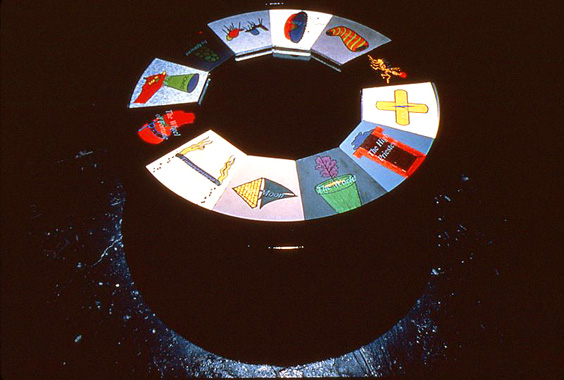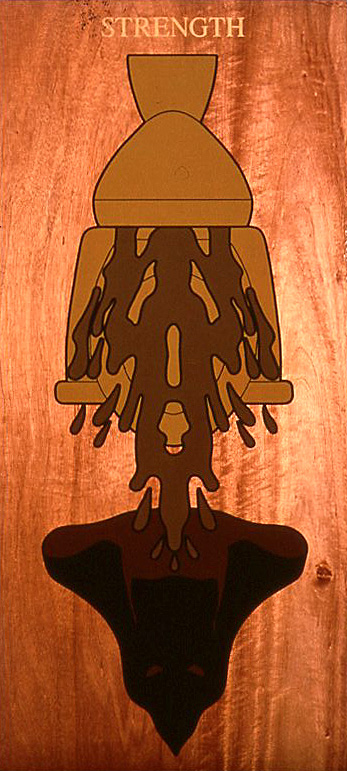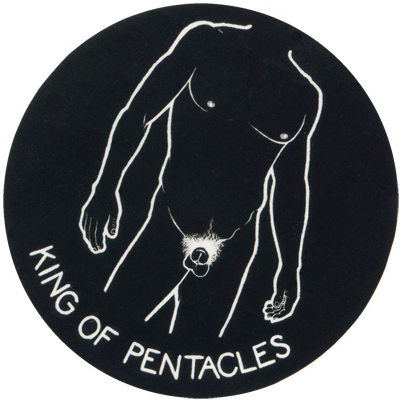Invert, Oracle
(1988)
Artist’s statement from the preface of the catalog
For many years I have been interested in the problems and possibilities of creating a work that deals with the nature of autobiography while avoiding the idioms of self-portraiture and linear narrative. Indeed, the experience of memory is never linear and self-image has little to do with one’s own reflection in the mirror.
In 1987, while recuperating from an accident and unable to work, I found myself thumbing through the instruction book for a deck of Tarot cards. I was intrigued with the methodical way in which this “oracle” divided up the possible range of human experience, and although it was geared towards a divination of the future, I found it to be a useful structure for the ordering of an autobiographical project.
Invert, Oracle was conceived as an installation consisting of paintings, drawings and texts. The installation is an enclosed room, approximately sixteen feet by sixteen feet and fourteen feet high, taking its general visual cues from both a fortune-tellers tent and mausoleum. On the exterior of the installation are two “tent flaps” that act as both entrance and explanation of the objects inside. On thispanel are 78 text panels, each pairing definitions of the individual Tarot cards with reminiscences generated by these definitions.
The interior of the installation is divided into three sections.
The Major Arcana of the Tarot, twenty-two cards in all, was divided into masculine and feminine aspects, ten of them are panels regarding memories of my father, (the large paintings on the doors suspended from the ceiling, together entitled Father), and twelve for memories of my mother (the sections of the circular table, entitled Mother).
The Minor Arcana, fifty-six cards in all, is used for autobiographical memories, and is represented by the fifty-six small circular drawings (jointly entitled Autobiography) scattered on the interior walls of the installation.
For many years I have been interested in the problems and possibilities of creating a work that deals with the nature of autobiography while avoiding the idioms of self-portraiture and linear narrative. Indeed, the experience of memory is never linear and self-image has little to do with one’s own reflection in the mirror.
In 1987, while recuperating from an accident and unable to work, I found myself thumbing through the instruction book for a deck of Tarot cards. I was intrigued with the methodical way in which this “oracle” divided up the possible range of human experience, and although it was geared towards a divination of the future, I found it to be a useful structure for the ordering of an autobiographical project.
Invert, Oracle was conceived as an installation consisting of paintings, drawings and texts. The installation is an enclosed room, approximately sixteen feet by sixteen feet and fourteen feet high, taking its general visual cues from both a fortune-tellers tent and mausoleum. On the exterior of the installation are two “tent flaps” that act as both entrance and explanation of the objects inside. On thispanel are 78 text panels, each pairing definitions of the individual Tarot cards with reminiscences generated by these definitions.
The interior of the installation is divided into three sections.
The Major Arcana of the Tarot, twenty-two cards in all, was divided into masculine and feminine aspects, ten of them are panels regarding memories of my father, (the large paintings on the doors suspended from the ceiling, together entitled Father), and twelve for memories of my mother (the sections of the circular table, entitled Mother).
The Minor Arcana, fifty-six cards in all, is used for autobiographical memories, and is represented by the fifty-six small circular drawings (jointly entitled Autobiography) scattered on the interior walls of the installation.




Acrylic & polyurethane on mahogany hollow core door, 80”x 36”







Press
Artweek
October 22, 1988
October 22, 1988